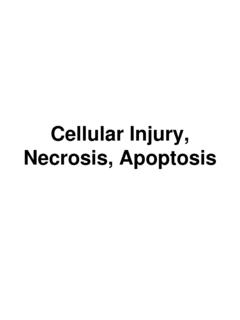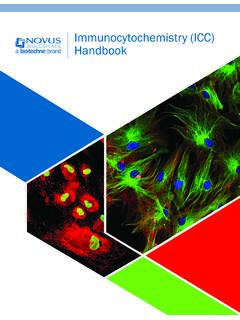Transcription of Content Sheet 8-1: Overview of Quality Control for ...
1 QC Qualitative and Semi-quantitative Procedures Module 8 Content Sheet 1 Content Sheet 8-1: Overview of Quality Control for Qualitative and Semi-quantitative Procedures Role in Quality management system Quality Control (QC) is a component of process Control , and is a major element of the Quality management system. It monitors the processes related to the examination phase of testing and allows for detecting errors in the testing system. These errors may be due to test system failure, adverse environmental conditions, or operator gives the laboratory confidence that test results are accurate and reliable before patient results are reported. This module explains how QC methods are applied to qualitative and semi-quantitative laboratory examinations.
2 Qualitative and semi-quantitative examinations Qualitative examinations are those that measure the presence or absence of a substance, or evaluate cellular characteristics such as morphology. The results are not expressed in numerical terms, but in descriptive or qualitative terms such as positive, negative, reactive, non-reactive, normal, or abnormal . Examples of qualitative examinations include microscopic examinations for cell morphology or presence of parasitic organisms, serologic procedures for presence or absence of antigens and antibodies, some microbiological procedures, and some molecular techniques. Semi-quantitative examinations are similar to qualitative examinations; testing does not measure the precise quantity of a substance.
3 The difference is that results of these tests are expressed as an estimate of how much of a measured substance is present. This estimate is sometimes reported as a number. Therefore, test results for semi-quantitative tests may be shown as trace amount , 1+, 2+, or 3+ , or positive at 1:160 (titer or dilution). Examples of semi-quantitative examinations are urine dipsticks, tablet tests for ketones, and serological agglutination procedures. Organization Personnel Equipment Purchasing & Inventory Process Control Information Management Documents & Records Occurrence Management Assessment Process Improvement Customer Service Facilities & Safety QC Qualitative and Semi-quantitative Procedures Module 8 Content Sheet 2 Some microscopic examinations are considered semi-quantitative because results are reported as estimates of the number of cells seen per low power field or high power field.
4 For example, a urine microscopic examination might report: 0-5 red blood cells seen per high power field. Important concepts As with quantitative procedures, it is important to verify that results of qualitative and semi-quantitative examinations are correct prior to reporting them to the requesting healthcare provider. Conducting Quality Control for many of these tests is not as easily accomplished as with quantitative tests. Therefore, it becomes essential that other processes within the Quality system are carefully conducted, in addition to traditional Quality Control methods. Following are some important over-arching concepts for Quality that apply to qualitative and semi-quantitative tests. Sample management is important in all laboratory testing.
5 Examinations that are dependent on a viable organism in the sample may need closer monitoring and better communication with non-laboratory staff (see Sample Management Module 5). Dedicated, professional staff who understand the principles of QC are key to Quality . Incubators, refrigerators, microscopes, autoclaves, and other equipment must be maintained and monitored carefully(see Equipment Management Module 3). Positive and negative controls must be used to monitor the effectiveness of test procedures that use special stains or reagents, tests with endpoints such as agglutination, color change, or other non-numeric results. Reagents should be stored according to manufacturer s instructions, labelled with the date they are opened and put into use, and discarded at the expiration date (see Purchasing and Inventory Module 4).
6 Keeping records of all Quality Control processes and corrective actions is necessary for continual improvement of the laboratory Quality system (see Documents and Records Module 16). When problems occur, investigate, correct, and repeat patient testing (see Occurrence Management Module14). If QC results are not what is expected, do not report patient results. QC Qualitative and Semi-quantitative Procedures Module 8 Content Sheet 3 Content Sheet 8-2: Quality Control Materials Control types Qualitative and semi-quantitative examinations include tests that utilize a variety of Control materials. These controls may be built-in (on-board, or procedural) controls, traditional controls that mimic patient samples, or may consist of stock cultures for use with microbiological examinations.
7 Built-in controls Built-in controls are those that are integrated into the design of a test system such as a test kit device. Usually, the device is marked with designated areas where colored lines, bars, or dots should appear to indicate success or failure of positive and negative controls, and these controls are performed automatically with each test. The manufacturer s product instructions may also refer to these as procedural controls, on-board controls, or internal controls. Most built-in controls monitor only a portion of the examination phase, and they vary from one test to another as to what is being monitored. For example, built-in controls for some kits may indicate that all the reagents impregnated into the device are active and working properly, whereas built-in controls for other kits may only indicate that a sample was added and solutions flowed through the device correctly.
8 It is important to carefully read the instructions provided by the manufacturer to understand what the built-in controls monitor, and to determine whether additional controls may be needed. Examples of test kits with built-in controls are rapid tests that detect the presence of antigens or antibodies, such as those for infectious disease (HIV/AIDS, influenza, Lyme Disease, streptococcal infection, infectious mononucleosis), drugs of abuse, pregnancy, or faecal occult blood. Even though these built-in controls give some degree of confidence, they do not monitor for all conditions that could affect test results. It is advisable to periodically test traditional Control materials that mimic patient samples, for added confidence in the accuracy and reliability of test results.
9 In some settings, these built-in controls are referred to as internal controls. Traditional controls Traditional Control materials are made to mimic patient samples, and they are tested with the patient samples to evaluate the examination component. Positive controls have known reactivity and negative controls are non-reactive for the analyte being tested. The controls should have the same composition, or matrix, as patient samples, including viscosity, turbidity, and color, in order to properly evaluate the test performance. Control materials are often lyophilized when received, and need to be carefully reconstituted before use. Some manufacturers may provide these controls with their test kits, but more frequently, QC Qualitative and Semi-quantitative Procedures Module 8 Content Sheet 4 they need to be purchased separately.
10 Traditional controls evaluate the testing process more broadly than built-in controls. They assess the integrity of the entire test system, the suitability of the physical testing environment (temperature, humidity, level workspace), and whether the person conducting the test performs it correctly. Positive and negative controls are recommended for many qualitative and semi-quantitative tests, including some procedures that use special stains or reagents, and tests with endpoints such as agglutination or color change. These controls should generally be used with each test run. Use of controls will also help to validate a new lot number of test kits or reagents, to check on temperatures of storage and testing areas, and to evaluate the process when new testing personnel are carrying out the testing.













